Learning scales helps you to become a more complete musician. As a flute player and teacher with over 14 years’ experience, I’ve taught my fair share of scales. Here are fingering charts for all flute melodic minor scales and my top tips for success!
Flute Melodic Minor Scales
A Melodic Minor
Notes:
- Ascending: A, B, C, D, E, F#, G#, A
- Descending: A, G, F, E, D, C, B, A
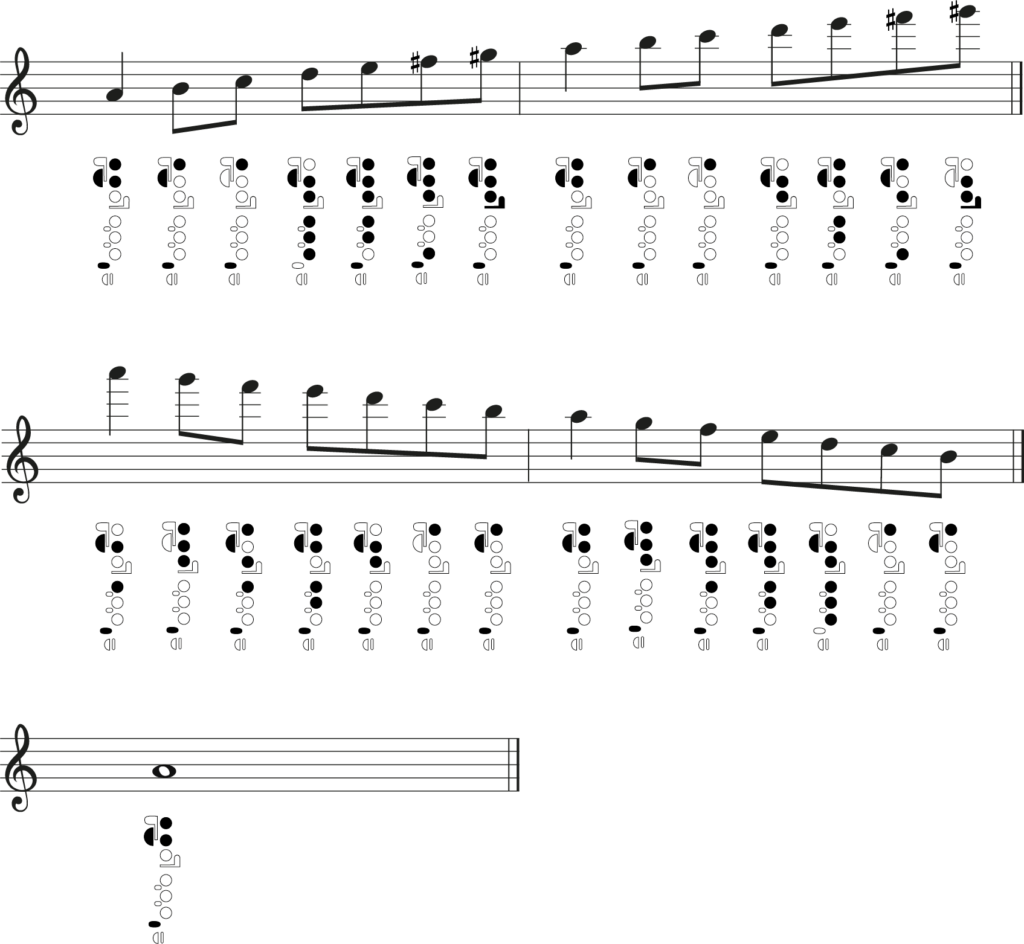
Flute melodic minor scales- Top tips for A melodic minor:
- Navigating the F# to G# Transition: The leap from F# to G# in the ascending form requires smooth finger coordination. Practice this segment slowly, focusing on minimizing finger movement noise, then gradually increase the tempo as your agility improves, ensuring a seamless transition between these notes.
- Maintaining Intonation on Raised 6th and 7th Degrees: The raised 6th (F#) and 7th (G#) degrees in the ascending form can challenge intonation, especially in the upper octave. Use a tuner to practice these notes in isolation, adjusting your embouchure to fine-tune their pitch, then integrate them into the scale, ensuring they blend harmoniously.
- Consistent Tone Quality Across Octaves: Achieving a uniform tone quality when transitioning from the lower A to the higher A, especially through the scale’s melodic changes, requires controlled air support and embouchure flexibility.
E Melodic Minor
Notes:
- Ascending: E, F#, G, A, B, C#, D#, E
- Descending: E, D, C, B, A, G, F#, E

Flute melodic minor scales- Top tips for E melodic minor:
- Smooth Transition from C# to D#: In the ascending form of E melodic minor, moving from C# to D# can be tricky due to the significant fingering change. Practice this transition slowly, emphasizing legato playing to ensure smoothness, then gradually increase the tempo while maintaining accuracy and fluidity.
- Intonation on Raised 6th and 7th (C# and D#): The raised 6th (C#) and 7th (D#) in the ascending scale can easily become sharp. Use a tuner to practice these notes individually, focusing on embouchure adjustments to achieve correct pitch. Then, practice integrating these notes into the scale, paying close attention to their intonation within the context.
- Consistent Tone Quality through Register Changes: Achieving an even tone from the lower E to the higher E, particularly through the shifts in the melodic minor’s ascending and descending forms, requires careful air support and embouchure control.
B Melodic Minor
Notes:
- Ascending: B, C#, D, E, F#, G#, A#, B
- Descending: B, A, G, F#, E, D, C#, B
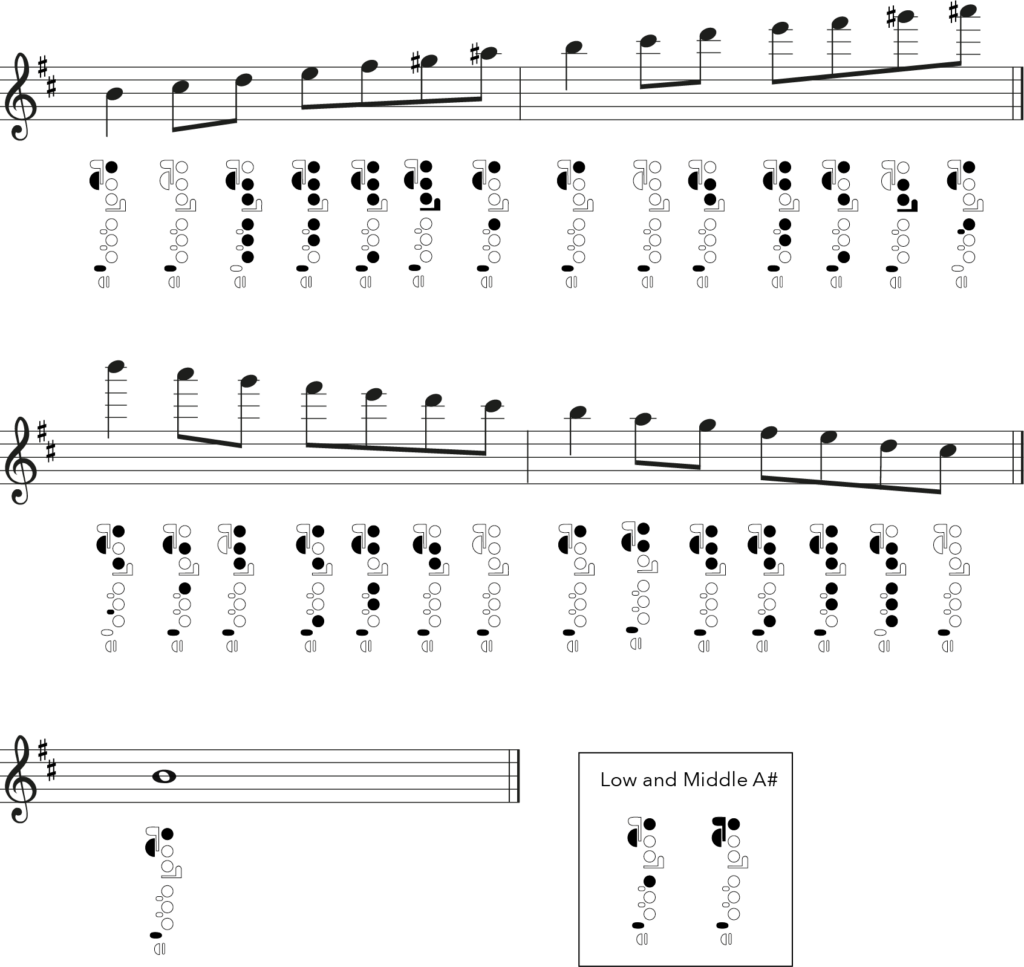
Flute melodic minor scales- Top tips for B melodic minor:
- Smooth Transition from C# to D#: In the ascending form of E melodic minor, moving from C# to D# can be tricky due to the significant fingering change. Practice this transition slowly, emphasizing legato playing to ensure smoothness, then gradually increase the tempo while maintaining accuracy and fluidity.
- Intonation on Raised 6th and 7th (C# and D#): The raised 6th (C#) and 7th (D#) in the ascending scale can easily become sharp. Use a tuner to practice these notes individually, focusing on embouchure adjustments to achieve correct pitch. Then, practice integrating these notes into the scale, paying close attention to their intonation within the context.
- Consistent Tone Quality through Register Changes: Achieving an even tone from the lower E to the higher E, particularly through the shifts in the melodic minor’s ascending and descending forms, requires careful air support and embouchure control.
F sharp Melodic Minor
Notes:
- Ascending: F#, G#, A, B, C#, D#, E# (F), F#
- Descending: F#, E, D, C#, B, A, G#, F#

Flute melodic minor scales- Top tips for F# melodic minor:
- Accurate Transition from E to F#: In the F# melodic minor scale, moving smoothly between E and the raised F# in the ascending form is crucial. Practice this transition slowly, focusing on precise finger placement and smooth execution, then gradually increase the tempo while ensuring the transition remains clean.
- Intonation on Raised 6th and 7th (D# and E#): The raised 6th (D#) and 7th (E#, enharmonically F) in the ascending scale can be challenging for intonation, with a tendency to be played sharp. Use a tuner to practice these notes individually, making slight embouchure adjustments for accurate pitch, then integrate them into the scale, paying special attention to their intonation.
- Even Tone Quality Through Register Shifts: Achieving consistent tone quality when transitioning from the lower F# to the higher F#, especially across the scale’s melodic changes, demands careful air support and embouchure control. Practice moving across registers with a focus on maintaining steady airflow and a relaxed embouchure to ensure a smooth, consistent tone throughout the scale.
C Sharp Melodic Minor
Notes:
- Ascending: C#, D#, E, F#, G#, A#, B# (C), C#
- Descending: C#, B, A, G#, F#, E, D#, C#
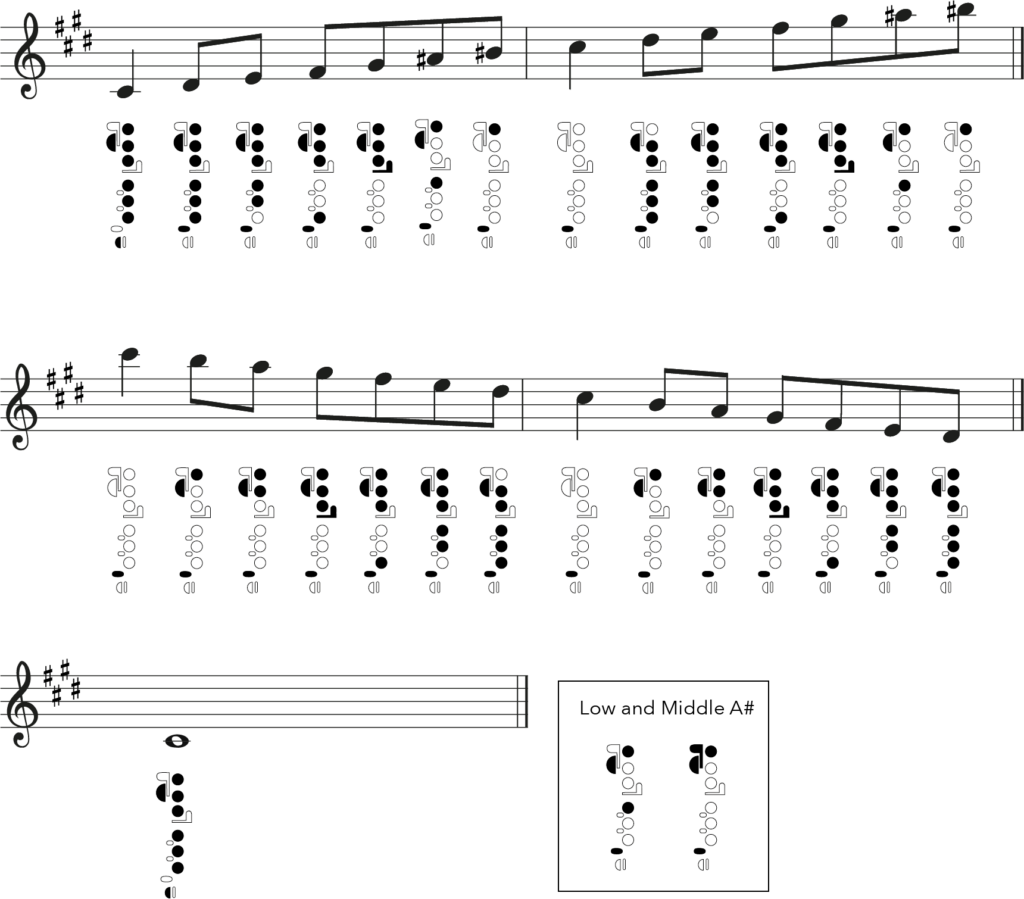
Flute melodic minor scales- Top tips for C# melodic minor:
- Smooth Transition from B to C#: In the ascending C# melodic minor scale, the transition from B to the raised C# can be challenging due to the fingerings involved. Practice this segment slowly, focusing on clean articulation and precise finger movement, then gradually increase speed while maintaining smoothness in the transition.
- Intonation on Raised 6th and 7th (A# and B#): The raised 6th (A#) and 7th (B#, enharmonically C) in the ascending portion can be difficult to intonate accurately, especially in the upper octave. Use a tuner to practice these notes in isolation, adjusting your embouchure to fine-tune their pitch. Then, integrate these notes into the scale, ensuring they blend well with the other notes in terms of intonation.
- Consistent Tone Quality Across Octaves: Maintaining an even tone from the lower C# to the higher C#, through the scale’s melodic variations, requires controlled air support and stable embouchure. Practice the scale in sections, focusing on smooth airflow and minimal embouchure change, aiming for a uniform tone quality throughout the scale, particularly during octave transitions.
G Sharp Melodic Minor
Notes:
- Ascending: G#, A#, B, C#, D#, E#, Fx (G), G#
- Descending: G#, F#, E, D#, C#, B, A#, G#
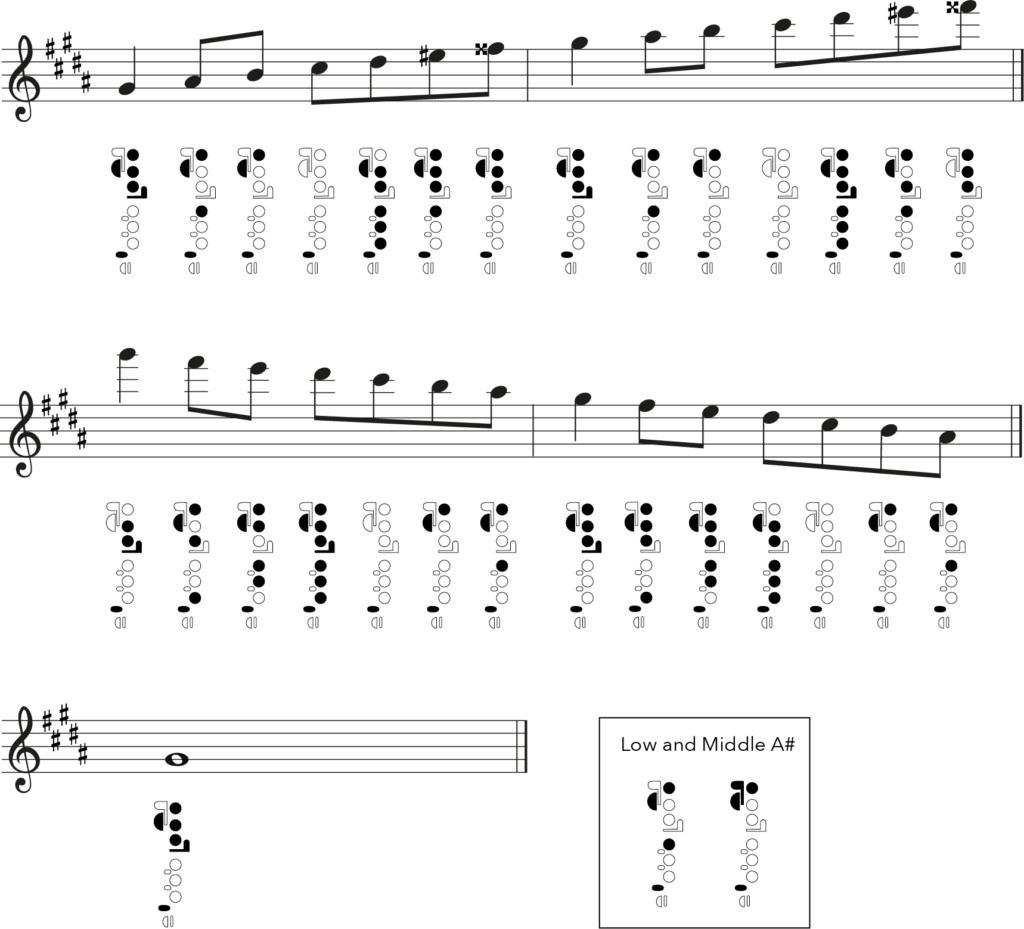
Flute melodic minor scales- Top tips for G# melodic minor:
- Accurate Transition from Fx to G#: In the ascending G# melodic minor scale, the transition from Fx (enharmonically G) to G# is crucial. Practice this segment slowly to ensure precise finger movements, focusing on the clarity of each note. Gradually increase the tempo while maintaining the smoothness of this transition.
- Intonation on Raised 6th and 7th (E# and Fx): The raised 6th (E#, enharmonically F) and 7th (Fx, enharmonically G) in the ascending form can present intonation challenges, often sounding sharp. Use a tuner to practice these notes in isolation, adjusting your embouchure to correct the pitch. Then, integrate these adjustments into the scale, paying close attention to the intonation of these raised notes within the scale context.
- Even Tone Quality Through Octave Shifts: Achieving consistent tone quality from the lower G# to the higher G#, especially through the melodic alterations in the ascending and descending forms, demands careful air support and embouchure control. Practice the scale in sections, focusing on maintaining steady airflow and a relaxed embouchure to ensure a smooth, consistent tone throughout the scale, particularly during octave transitions.
D Sharp Melodic Minor
Notes:
- Ascending: D#, E#, F#, G#, A#, B#, Cx (D), D#
- Descending: D#, C#, B, A#, G#, F#, E#, D#
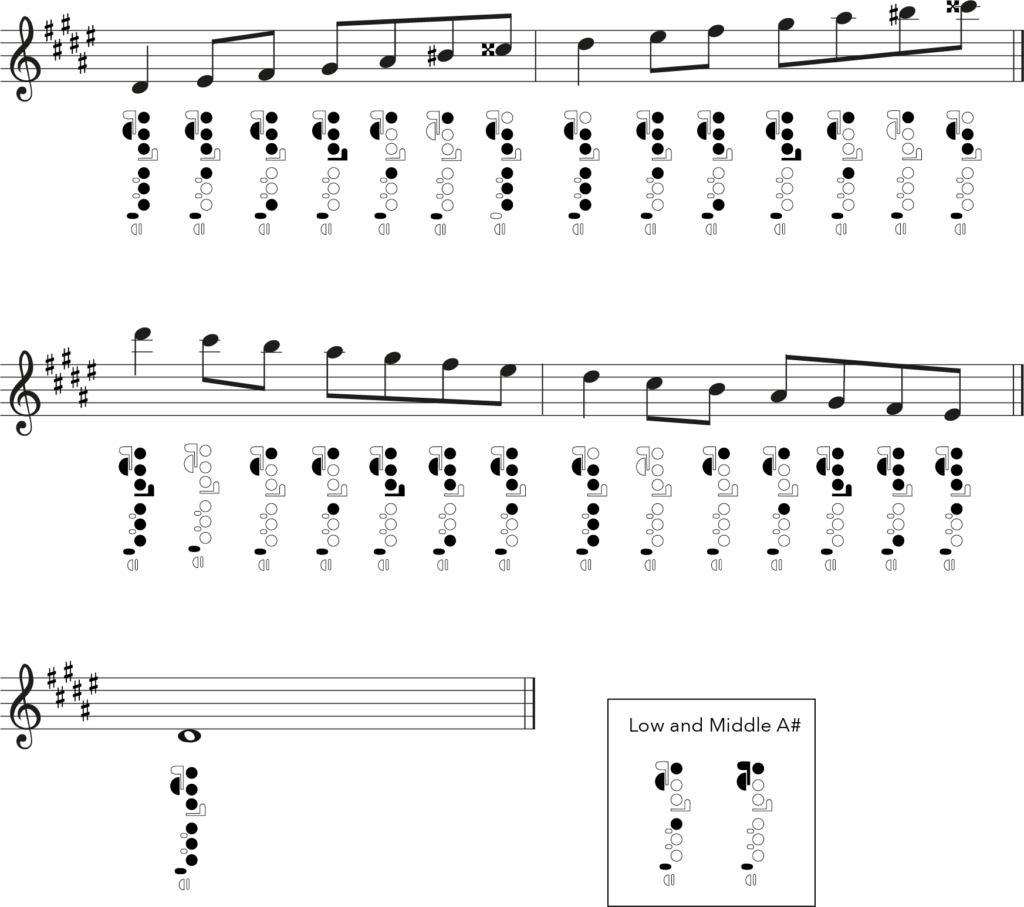
Flute melodic minor scales- Top tips for D# melodic minor:
- Smooth Transition from C# to D#: Moving cleanly between C# and D# in the ascending form requires careful finger coordination. Practice this transition slowly, emphasizing legato technique to ensure smoothness, then gradually increase the tempo while maintaining accuracy and fluidity.
- Intonation on Raised 6th and 7th (C# and D#): The raised 6th (C#) and 7th (D#) in the ascending scale can be challenging for intonation, often sounding sharp. Use a tuner to practice these notes in isolation, focusing on embouchure adjustments to achieve the correct pitch. Then, incorporate these notes into the scale, ensuring they blend harmoniously with the other notes.
- Consistent Tone Quality Across Octaves: Achieving an even tone from the lower D# to the higher D#, especially through the melodic changes in the ascending and descending forms, requires controlled air support and stable embouchure.
D Melodic Minor
Notes:
- Ascending: D, E, F, G, A, B, C#, D
- Descending: D, C, B♭, A, G, F, E, D

Top tips for D melodic minor:
- Smooth Transition from B to C#: In the ascending D melodic minor scale, moving from B to the raised C# smoothly is essential. Practice this transition slowly, focusing on accurate finger placement and smooth execution. Gradually increase the speed while ensuring the transition remains clean and legato.
- Intonation on Raised 6th and 7th (B and C#): The raised 6th (B) and 7th (C#) in the ascending form can challenge intonation, particularly in the upper octaves. Use a tuner to practice these notes individually, adjusting your embouchure to fine-tune their pitch. Then, practice integrating these adjustments into the scale, focusing on seamless intonation throughout.
- Consistent Tone Quality Across Registers: Maintaining an even tone across the scale, especially through the octave leaps and melodic changes between ascending and descending forms, requires careful air support and embouchure control.
G Melodic Minor
Notes:
- Ascending: G, A, B♭, C, D, E, F#, G
- Descending: G, F, E♭, D, C, B♭, A, G

Top tips for G melodic minor:
- Smooth Transition from E to F#: In the ascending G melodic minor scale, the movement from E to the raised F# is crucial for maintaining the melodic flow. Practice this transition slowly to ensure precise finger movement and clean articulation, then gradually increase the tempo while keeping the transition smooth.
- Intonation on Raised 6th and 7th (E and F#): The raised 6th (E) and 7th (F#) in the ascending form can be challenging for intonation, with a tendency to sound sharp. Use a tuner to practice these notes in isolation, focusing on embouchure adjustments to correct pitch. Then, integrate these notes into the scale, ensuring they blend well with the surrounding notes.
- Even Tone Quality Through Register Changes: Achieving a consistent tone across the transition from the lower G to the higher G, particularly through the melodic alterations in the ascending and descending forms, demands controlled air support and stable embouchure.
C Melodic Minor
Notes:
- Ascending: C, D, E♭, F, G, A, B, C
- Descending: C, B♭, A♭, G, F, E♭, D, C
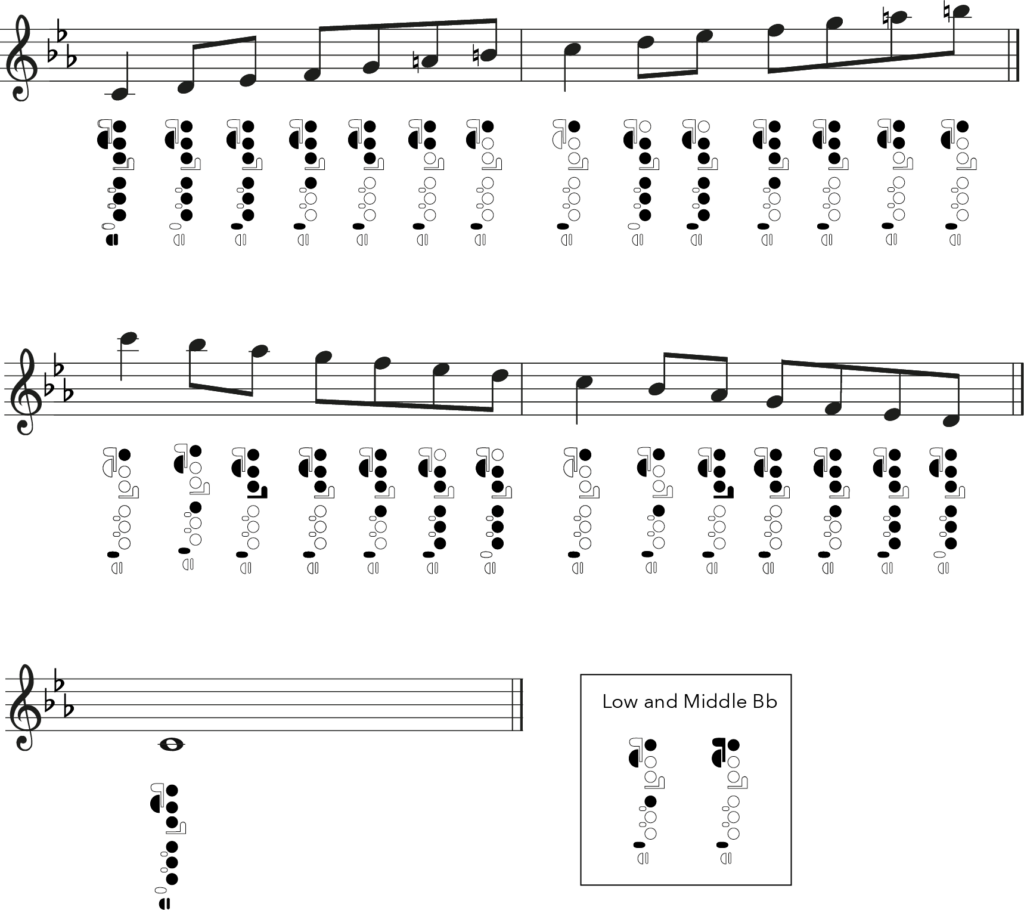
Top tips for C melodic minor:
- Smooth Transition from G to A: In the ascending C melodic minor scale, moving smoothly between G and the raised A is essential. Practice this transition slowly to ensure accurate finger movement and clear articulation, then gradually increase the speed while maintaining smoothness.
- Intonation on Raised 6th and 7th (A and B): The raised 6th (A) and 7th (B) in the ascending form can present intonation challenges, often sounding sharp. Use a tuner to practice these notes in isolation, adjusting your embouchure to achieve the correct pitch. Then, practice integrating these adjustments into the scale, ensuring seamless intonation across all notes.
- Consistent Tone Quality Across Registers: Maintaining an even tone throughout the scale, especially when transitioning from the lower C to the higher C through the melodic changes, requires controlled air support and a stable embouchure.
F Melodic Minor
Notes:
- Ascending: F, G, A♭, B♭, C, D, E, F
- Descending: F, E♭, D♭, C, B♭, A♭, G, F

Top tips for F melodic minor:
- Smooth Transition from D to E: In the ascending F melodic minor scale, the movement from D to the raised E requires careful fingering to ensure smoothness. Practice this transition slowly, focusing on precise finger movements to ensure each note is articulated cleanly, then gradually increase the tempo while maintaining the smooth connection between these notes.
- Intonation on Raised 6th and 7th (E and F): The raised 6th (E) and 7th (F) in the ascending form can be difficult to intonate accurately, especially in the upper octaves. Use a tuner to practice these notes in isolation, adjusting your embouchure to fine-tune their pitch. Then, incorporate these notes into the scale, focusing on their integration and intonation with the rest of the scale.
- Consistent Tone Quality Across Octaves: Achieving an even tone across the scale, particularly through the transitions from the lower F to the higher F, involves careful air support and embouchure control. Practice the scale in sections, focusing on maintaining steady airflow and minimal embouchure changes.
B Flat Melodic Minor
Notes:
- Ascending: B♭, C, D♭, E♭, F, G, A, B♭
- Descending: B♭, A♭, G♭, F, E♭, D♭, C, B♭

Top tips for Bb melodic minor:
- Smooth Transition from G to A: In the ascending B♭ melodic minor scale, moving smoothly between G and the raised A is crucial. Practice this transition slowly, focusing on accurate finger movement and clear articulation, then gradually increase the speed while maintaining the smoothness of this transition.
- Intonation on Raised 6th and 7th (A and B): The raised 6th (A) and 7th (B) in the ascending form can present intonation challenges, often sounding sharp. Use a tuner to practice these notes in isolation, adjusting your embouchure to correct pitch. Then, practice integrating these notes into the scale, ensuring they blend well with the other notes in terms of intonation.
- Consistent Tone Quality Across Registers: Maintaining an even tone throughout the scale, especially when transitioning from the lower B♭ to the higher B♭ through the melodic changes, requires controlled air support and a stable embouchure.
E Flat Melodic Minor
Notes:
- Ascending: E♭, F, G♭, A♭, B♭, C, D, E♭
- Descending: E♭, D♭, C♭, B♭, A♭, G♭, F, E♭
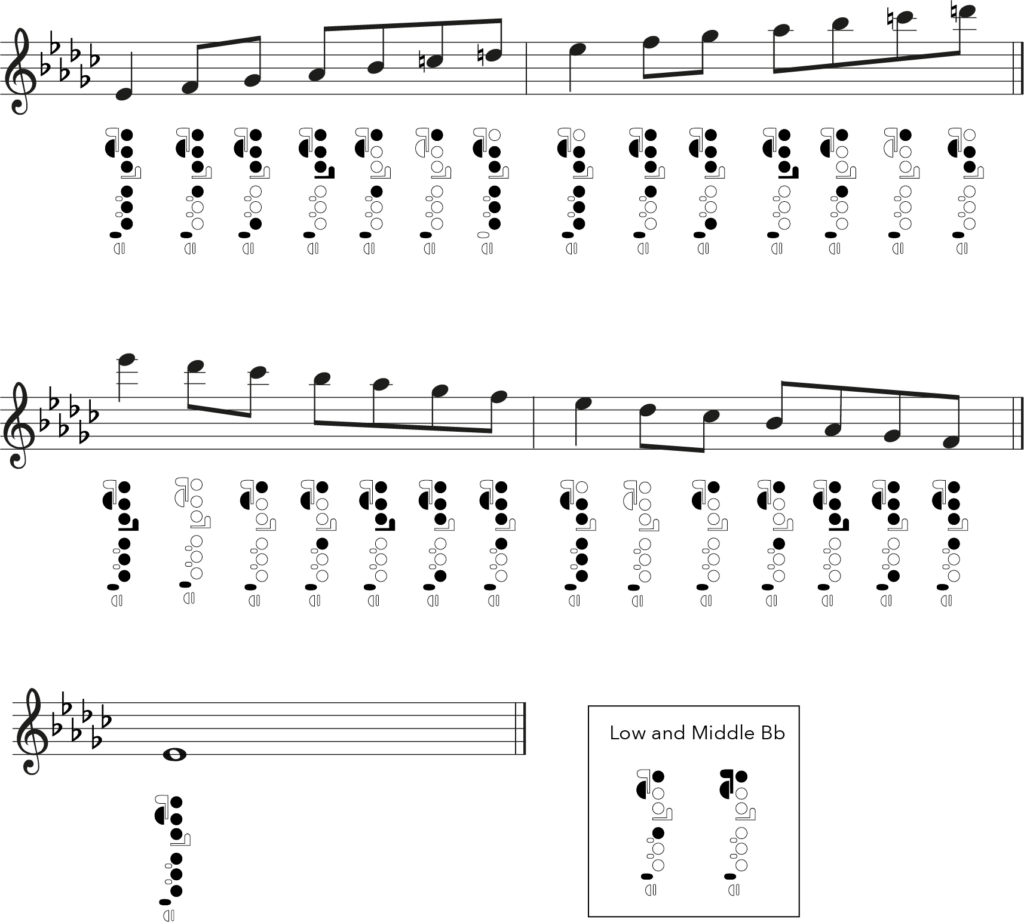
Top tips for Eb melodic minor:
- Smooth Transition from C to D: In the ascending E♭ melodic minor scale, the movement from C to the raised D requires careful attention. Practice this segment slowly, focusing on precise finger movement to ensure a clean articulation between these notes. Gradually increase the tempo while maintaining the smoothness of this transition.
- Intonation on Raised 6th and 7th (D and E): The raised 6th (D) and 7th (E) in the ascending form can be challenging for intonation, with a tendency to sound sharp. Use a tuner to practice these notes in isolation, making slight embouchure adjustments to achieve the correct pitch. Then, integrate these notes into the scale, focusing on their harmonic blending with the rest of the scale.
- Consistent Tone Quality Through Octave Shifts: Achieving an even tone across the scale, particularly when transitioning from the lower E♭ to the higher E♭ through the melodic alterations, demands controlled air support and embouchure stability.
What’s next…?
- Learn flute major scales
- Learn natural minor scales for flute
- Learn harmonic minor flute scales
